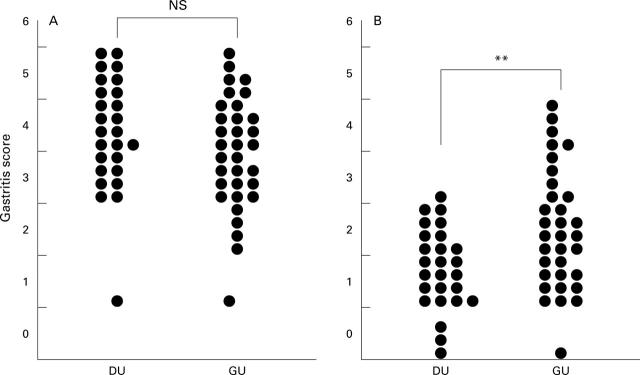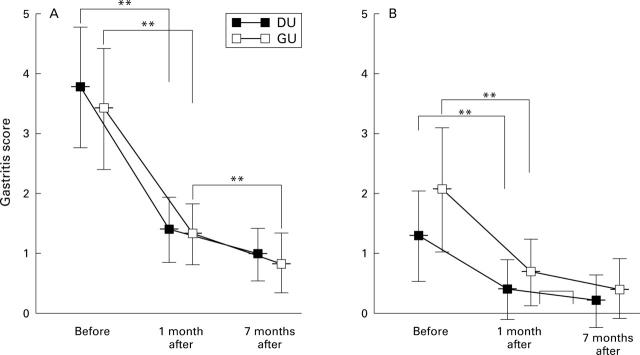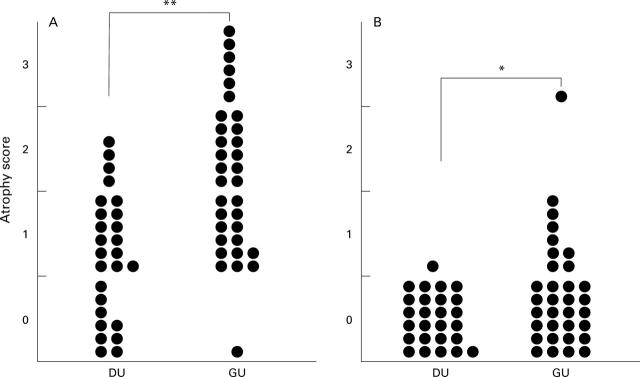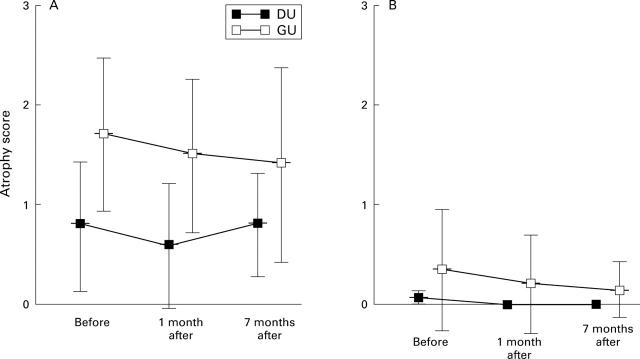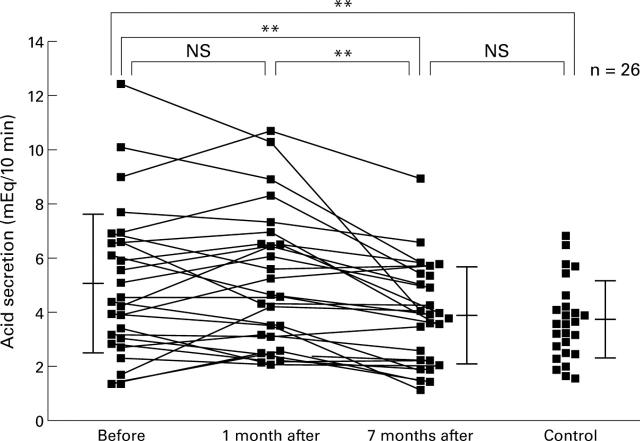Abstract
BACKGROUND—It remains controversial whether or not Helicobacter pylori infection causes altered gastric acid secretion. A novel test for evaluating gastric acid secretion (endoscopic gastrin test; EGT) has recently been developed. AIM—To investigate by EGT the effects of H pylori eradication on the state of gastric acid secretion in patients with peptic ulcer. METHODS—Twenty six patients with duodenal ulcer and 33 with gastric ulcer, for all of whom H pylori infection had been documented, were studied by EGT, histological examination of gastric mucosa, and measurement of plasma gastrin levels before and one and seven months after H pylori eradication. RESULTS—In patients with duodenal ulcer, the mean EGT value before H pylori eradication was higher than that in H pylori negative controls, but it had decreased significantly seven months after the treatment. In contrast, the mean EGT value of patients with gastric ulcer before H pylori eradication was lower than that in H pylori negative controls, but it had increased one month after the treatment; this was followed by a slight decrease at seven months. In both groups, mean EGT values seven months after the treatment were not significantly different from the mean control value. CONCLUSIONS—The reduced acid secretion in gastric ulcer patients and gastric acid hypersecretion in duodenal ulcer patients were both normalised after the clearance of H pylori. Keywords: acid secretion; duodenal ulcer; endoscopic gastrin test (EGT); gastric ulcer; Helicobacter pylori
Full Text
The Full Text of this article is available as a PDF (119.6 KB).
Figure 1 .
Gastritis scores of the antrum (A) and body (B). Before eradication of H pylori, the mean gastritis score of the antrum was not significantly different between the patients with duodenal ulcer (DU) and those with gastric ulcer (GU), but in the gastric body, it was significantly higher in the patients with GU than in those with DU. **p<0.01; NS, not significant.
Figure 2 .
Changes in gastritis score in the antrum (A) and body (B) caused by H pylori eradication. One month after the eradication treatment, the mean gastritis score in the antrum had fallen significantly in the patients with duodenal ulcer (DU) as well as in those with gastric ulcer (GU). Between one and seven months, the value decreased significantly only in those with GU. In the gastric body, the mean gastritis score had decreased significantly in both groups at one month. No further decrease was found in either group between one and seven months after the eradication. Vertical bars represent SD of the mean gastritis score. **p<0.01 compared with before.
Figure 3 .
Atrophy scores of the antrum (A) and body (B). Before eradication of H pylori, the mean atrophy score of the antrum in patients with gastric ulcer (GU) was significantly higher than that of patients with duodenal ulcer (DU). Similarly, the mean atrophy score of the gastric body was significantly higher in the patients with GU than patients with DU. *p<0.05, **p<0.01.
Figure 4 .
Changes in atrophy score in the antrum (A) and body (B) caused by H pylori eradication. After the eradication, the degree of antral or body atrophy did not change significantly in patients with either duodenal ulcer (DU) or gastric ulcer (GU). Vertical bars represent SD of the mean atrophy score.
Figure 5 .
Changes in acid secretion in patients with duodenal ulcer (DU) after H pylori eradication. In the H pylori positive patients with DU, the mean EGT value was significantly higher than that of H pylori negative controls. One month after the eradication, no significant change was found in the EGT value, but it had fallen significantly at seven months after the eradication. The value at seven months was not significantly different from the control value. Vertical bars represent SD of the mean. **p<0.01; NS, not significant.
Figure 6 .
Changes in acid secretion in patients with gastric ulcer (GU) after H pylori eradication. In the H pylori positive patients with GU, the mean EGT value was significantly lower than that of H pylori negative controls. One month after the eradication, the mean EGT value increased significantly, and then decreased slightly but significantly at seven months. The value at seven months was not significantly different from the control value, but it was still higher than that before eradication. Vertical bars represent SD of the mean. *p<0.05, **p<0.01, NS, not significant.
Selected References
These references are in PubMed. This may not be the complete list of references from this article.
- Barr G. D., Kang J. Y., Canalese J., Piper D. W. A two-year prospective controlled study of maintenance cimetidine and gastric ulcer. Gastroenterology. 1983 Jul;85(1):100–104. [PubMed] [Google Scholar]
- Bechi P., Romagnoli P., Bacci S., Dei R., Amorosi A., Cianchi F., Masini E. Helicobacter pylori and duodenal ulcer: evidence for a histamine pathways-involving link. Am J Gastroenterol. 1996 Nov;91(11):2338–2343. [PubMed] [Google Scholar]
- Burland W. L., Hawkins B. W., Beresford J. Cimetidine treatment for the prevention of recurrence of duodenal ulcer: an international collaborative study. Postgrad Med J. 1980 Mar;56(653):173–176. doi: 10.1136/pgmj.56.653.173. [DOI] [PMC free article] [PubMed] [Google Scholar]
- Cave D. R., Vargas M. Effect of a Campylobacter pylori protein on acid secretion by parietal cells. Lancet. 1989 Jul 22;2(8656):187–189. doi: 10.1016/s0140-6736(89)90372-3. [DOI] [PubMed] [Google Scholar]
- Chiba N., Rao B. V., Rademaker J. W., Hunt R. H. Meta-analysis of the efficacy of antibiotic therapy in eradicating Helicobacter pylori. Am J Gastroenterol. 1992 Dec;87(12):1716–1727. [PubMed] [Google Scholar]
- El-Omar E. M., Oien K., El-Nujumi A., Gillen D., Wirz A., Dahill S., Williams C., Ardill J. E., McColl K. E. Helicobacter pylori infection and chronic gastric acid hyposecretion. Gastroenterology. 1997 Jul;113(1):15–24. doi: 10.1016/s0016-5085(97)70075-1. [DOI] [PubMed] [Google Scholar]
- Forbes G. M., Glaser M. E., Cullen D. J., Warren J. R., Christiansen K. J., Marshall B. J., Collins B. J. Duodenal ulcer treated with Helicobacter pylori eradication: seven-year follow-up. Lancet. 1994 Jan 29;343(8892):258–260. doi: 10.1016/s0140-6736(94)91111-8. [DOI] [PubMed] [Google Scholar]
- Furuta T., Baba S., Takashima M., Futami H., Arai H., Kajimura M., Hanai H., Kaneko E. Effect of Helicobacter pylori infection on gastric juice pH. Scand J Gastroenterol. 1998 Apr;33(4):357–363. doi: 10.1080/00365529850170973. [DOI] [PubMed] [Google Scholar]
- Gisbert J. P., Boixeda D., Vila T., de Rafael L., Redondo C., de Argila C. M. Basal and stimulated gastrin levels and gastric acid output five months after therapy for Helicobacter pylori eradication in duodenal ulcer patients. J Clin Gastroenterol. 1996 Mar;22(2):90–95. doi: 10.1097/00004836-199603000-00003. [DOI] [PubMed] [Google Scholar]
- Gough K. R., Korman M. G., Bardhan K. D., Lee F. I., Crowe J. P., Reed P. I., Smith R. N. Ranitidine and cimetidine in prevention of duodenal ulcer relapse. A double-blind, randomised, multicentre, comparative trial. Lancet. 1984 Sep 22;2(8404):659–662. doi: 10.1016/s0140-6736(84)91224-8. [DOI] [PubMed] [Google Scholar]
- Graham D. Y., Lew G. M., Klein P. D., Evans D. G., Evans D. J., Jr, Saeed Z. A., Malaty H. M. Effect of treatment of Helicobacter pylori infection on the long-term recurrence of gastric or duodenal ulcer. A randomized, controlled study. Ann Intern Med. 1992 May 1;116(9):705–708. doi: 10.7326/0003-4819-116-9-705. [DOI] [PubMed] [Google Scholar]
- Gutierrez O., Melo M., Segura A. M., Angel A., Genta R. M., Graham D. Y. Cure of Helicobacter pylori infection improves gastric acid secretion in patients with corpus gastritis. Scand J Gastroenterol. 1997 Jul;32(7):664–668. doi: 10.3109/00365529708996515. [DOI] [PubMed] [Google Scholar]
- Harris A. W., Gummett P. A., Misiewicz J. J., Baron J. H. Eradication of Helicobacter pylori in patients with duodenal ulcer lowers basal and peak acid outputs to gastrin releasing peptide and pentagastrin. Gut. 1996 May;38(5):663–667. doi: 10.1136/gut.38.5.663. [DOI] [PMC free article] [PubMed] [Google Scholar]
- Iijima K., Ohara S., Sekine H., Koike T., Kubota Y., Kato K., Asaki S., Toyota T. A new endoscopic method of gastric acid secretory testing. Am J Gastroenterol. 1998 Nov;93(11):2113–2118. doi: 10.1111/j.1572-0241.1998.00603.x. [DOI] [PubMed] [Google Scholar]
- Jensen K. B., Møllmann K. M., Rahbek I., Madsen J. R., Rune S. J., Wulff H. R. Prophylactic effect of cimetidine in gastric ulcer patients. Scand J Gastroenterol. 1979;14(2):175–176. doi: 10.3109/00365527909179865. [DOI] [PubMed] [Google Scholar]
- Johnson H. D. Gastric ulcer: classification, blood group characteristics, secretion patterns and pathogenesis. Ann Surg. 1965 Dec;162(6):996–1004. doi: 10.1097/00000658-196512000-00005. [DOI] [PMC free article] [PubMed] [Google Scholar]
- Johnson L. R. The trophic action of gastrointestinal hormones. Gastroenterology. 1976 Feb;70(2):278–288. [PubMed] [Google Scholar]
- Laszewicz W., Zaremba-Woroniecka A., Gabryelewicz A. Helicobacter pylori infection and gastric secretion in duodenal and gastric ulcer patients--the effect of eradication after one year. J Physiol Pharmacol. 1997 Sep;48(3):353–364. [PubMed] [Google Scholar]
- Lee F. I., Reed P. I., Crowe J. P., McIsaac R. L., Wood J. R. Acute treatment of duodenal ulcer: a multicentre study to compare ranitidine 150 mg twice daily with ranitidine 300 mg once at night. Gut. 1986 Sep;27(9):1091–1095. doi: 10.1136/gut.27.9.1091. [DOI] [PMC free article] [PubMed] [Google Scholar]
- Levi S., Beardshall K., Desa L. A., Calam J. Campylobacter pylori, gastrin, acid secretion, and duodenal ulcers. Lancet. 1989 Sep 9;2(8663):613–613. doi: 10.1016/s0140-6736(89)90728-9. [DOI] [PubMed] [Google Scholar]
- Levi S., Beardshall K., Haddad G., Playford R., Ghosh P., Calam J. Campylobacter pylori and duodenal ulcers: the gastrin link. Lancet. 1989 May 27;1(8648):1167–1168. doi: 10.1016/s0140-6736(89)92752-9. [DOI] [PubMed] [Google Scholar]
- Louw J. A., Falck V., van Rensburg C., Zak J., Adams G., Marks I. N. Distribution of Helicobacter pylori colonisation and associated gastric inflammatory changes: difference between patients with duodenal and gastric ulcers. J Clin Pathol. 1993 Aug;46(8):754–756. doi: 10.1136/jcp.46.8.754. [DOI] [PMC free article] [PubMed] [Google Scholar]
- Machell R. J., Ciclitira P. J., Farthing M. J., Dick A. P., Hunter J. O. Cimetidine in the prevention of gastric ulcer relapse. Postgrad Med J. 1979 Jun;55(644):393–395. doi: 10.1136/pgmj.55.644.393. [DOI] [PMC free article] [PubMed] [Google Scholar]
- Moss S. F., Calam J. Acid secretion and sensitivity to gastrin in patients with duodenal ulcer: effect of eradication of Helicobacter pylori. Gut. 1993 Jul;34(7):888–892. doi: 10.1136/gut.34.7.888. [DOI] [PMC free article] [PubMed] [Google Scholar]
- Noach L. A., Bosma N. B., Jansen J., Hoek F. J., van Deventer S. J., Tytgat G. N. Mucosal tumor necrosis factor-alpha, interleukin-1 beta, and interleukin-8 production in patients with Helicobacter pylori infection. Scand J Gastroenterol. 1994 May;29(5):425–429. doi: 10.3109/00365529409096833. [DOI] [PubMed] [Google Scholar]
- Ohara S., Kato M., Asaka M., Toyota T. Studies of 13C-urea breath test for diagnosis of Helicobacter pylori infection in Japan. J Gastroenterol. 1998 Feb;33(1):6–13. doi: 10.1007/pl00009968. [DOI] [PubMed] [Google Scholar]
- Parente F., Maconi G., Sangaletti O., Minguzzi M., Vago L., Bianchi Porro G. Behaviour of acid secretion, gastrin release, serum pepsinogen I, and gastric emptying of liquids over six months from eradication of helicobacter pylori in duodenal ulcer patients. A controlled study. Gut. 1995 Aug;37(2):210–215. doi: 10.1136/gut.37.2.210. [DOI] [PMC free article] [PubMed] [Google Scholar]
- Pisegna J. R., Norton J. A., Slimak G. G., Metz D. C., Maton P. N., Gardner J. D., Jensen R. T. Effects of curative gastrinoma resection on gastric secretory function and antisecretory drug requirement in the Zollinger-Ellison syndrome. Gastroenterology. 1992 Mar;102(3):767–778. doi: 10.1016/0016-5085(92)90157-t. [DOI] [PubMed] [Google Scholar]
- Ragins H., Wincze F., Liu S. M., Dittbrenner M. Theorigin and survival of gastric parietal cells in the mouse. Anat Rec. 1968 Sep;162(1):99–110. doi: 10.1002/ar.1091620109. [DOI] [PubMed] [Google Scholar]
- Tatsuta M., Iishi H., Okuda S. Effects of cimetidine on the healing and recurrence of duodenal ulcers and gastric ulcers. Gut. 1986 Oct;27(10):1213–1218. doi: 10.1136/gut.27.10.1213. [DOI] [PMC free article] [PubMed] [Google Scholar]
- Tucci A., Biasco G., Paparo G. F. Effect of eradication of Helicobacter pylori in patients with fundic atrophic gastritis. N Engl J Med. 1997 Mar 27;336(13):957–958. doi: 10.1056/NEJM199703273361313. [DOI] [PubMed] [Google Scholar]
- Van der Hulst R. W., Tytgat G. N. Helicobacter pylori and peptic ulcer disease. Scand J Gastroenterol Suppl. 1996;220:10–18. [PubMed] [Google Scholar]
- Walsh J. H., Richardson C. T., Fordtran J. S. pH dependence of acid secretion and gastrin release in normal and ulcer subjects. J Clin Invest. 1975 Mar;55(3):462–468. doi: 10.1172/JCI107952. [DOI] [PMC free article] [PubMed] [Google Scholar]
- Weigert N., Schaffer K., Schusdziarra V., Classen M., Schepp W. Gastrin secretion from primary cultures of rabbit antral G cells: stimulation by inflammatory cytokines. Gastroenterology. 1996 Jan;110(1):147–154. doi: 10.1053/gast.1996.v110.pm8536851. [DOI] [PubMed] [Google Scholar]
- Willems G., Lehy T. Radioautographic and quantitative studies on parietal and peptic cell kinetics in the mouse. A selective effect of gastrin on parietal cell proliferation. Gastroenterology. 1975 Aug;69(2):416–426. [PubMed] [Google Scholar]
- Yasunaga Y., Shinomura Y., Kanayama S., Yabu M., Nakanishi T., Miyazaki Y., Murayama Y., Bonilla-Palacios J. J., Matsuzawa Y. Improved fold width and increased acid secretion after eradication of the organism in Helicobacter pylori associated enlarged fold gastritis. Gut. 1994 Nov;35(11):1571–1574. doi: 10.1136/gut.35.11.1571. [DOI] [PMC free article] [PubMed] [Google Scholar]
- el-Omar E. M., Penman I. D., Ardill J. E., Chittajallu R. S., Howie C., McColl K. E. Helicobacter pylori infection and abnormalities of acid secretion in patients with duodenal ulcer disease. Gastroenterology. 1995 Sep;109(3):681–691. doi: 10.1016/0016-5085(95)90374-7. [DOI] [PubMed] [Google Scholar]



